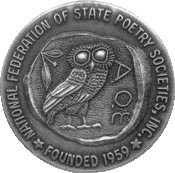-->
Paris, 7 A.M.
I make a trip to each clock in the apartment:
some hands point histrionically one way
and some point others, from the ignorant faces.
Time is an Etoile; the hours diverge
so much that days are journeys round the suburbs,
circles surrounding stars, overlapping circles.
The short, half-tone scale of winter weathers
is a spread pigeon's wing.
Winter lives under a pigeon's wing, a dead wing with damp feathers.
Look down into the courtyard. All the houses
are built that way, with ornamental urns
set on the mansard roof-tops where the pigeons
take their walks. It is like introspection
to stare inside, or retrospection,
a star inside a rectangle, a recollection:
this hollow square could easily have been there.
– The childish snow forts, built in flashier winters,
could have reached these proportions and been houses;
the mighty snow-forts, four, five, stories high,
withstanding spring as sand-forts do the tide,
their walls, their shape, could not dissolve and die,
only be overlapping in a strong chain, turned to stone,
and grayed and yellowed now like these.
Where is the ammunition, the piled-up balls
with the star-splintered hearts of ice?
This sky is no carrier-warrior-pigeon
escaping endless intersecting circles.
It is a dead one, or the sky from which a dead one fell.
The urns have caught his ashes or his feathers.
When did the star dissolve, or was it captured
by the sequence of squares and squares and circles, circles?
Can the clocks say; is it there below,
about to tumble in snow?
In Bishop's first book of poems, North & South (1946, Houghton Mifflin), this poem is the sixteenth of thirty. It is preceded by poems which are more well-known, including “Wading at Wellfleet”, “The Man-Moth”, and “The Unbeliever”. The poems following this one in her first book are anthologized even less often than this one, although The Poetry Foundation has posted “Roosters” online here.
The scene of “Paris, 7 A.M.” is a dreamlike state of consciousness in which one observes but does nothing. The speaking persona goes anxiously from clock to clock within “the apartment”, and then goes to the window and looks down at the courtyard and up at the sky, but there is no leaving the apartment or other action within it. The sense of stasis is bolstered by the notion of deadness in the absence of death:
Winter lives under a pigeon's wing, a dead wing with damp feathers. (lines 9 to 10)
The childish snow-forts...could not dissolve and die... (lines 18 to 22)
This sky...is a dead one, or the sky from which a dead one fell. (lines 27 to 29)
What can we say about why this person is anxious? We get a clue early in the poem: “days are journeys round the suburbs” (line five). Using Surrealism to conflate a cosmological perspective with that of a domestic one in these early lines, we are left with the question: “What is the urban?” The poem provides no answer, and a memory of “flashier winters” provides no solace, no re-invigoration. This poem does not clarify, elaborate or affirm but disorients and troubles. The “I” is casting about, attending first to this, then to that, and not finding a place to feel at ease.
Another clue as to this anxiety comes in lines 14 to 17:
… It is like introspection
to stare inside, or retrospection,
a star inside a rectangle, a recollection:
this hollow square could easily have been there.
Usually, retrospection and introspection are expected to be separate, even mutually exclusive, territories. But here the speaking persona seeks to collapse these territories into one. The “It” of line 14 is the scene in the courtyard; the “I” would like her interior and her exterior weathers to be the same. But they are not, and this disappoints her, causing her some anxiety.
After looking down into the lifeless courtyard and reflecting on a childhood memory that doesn't seem to help, this person wants to know where the signs of life are (“Where is the ammunition...?”). With no one else to turn to, she wants to know if the clocks can tell her what she wants to know. The “it” of the line next to last includes the pigeon, the Etoile (i.e., the star) and the sky, and the final question of the poem asks, “Is a catastrophe about to happen?”
















